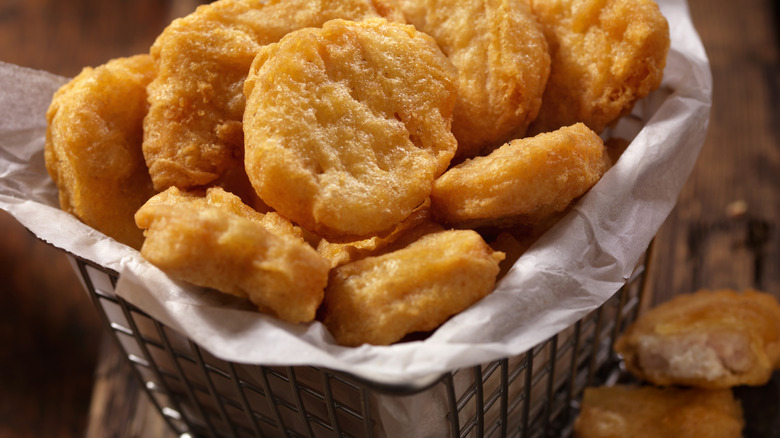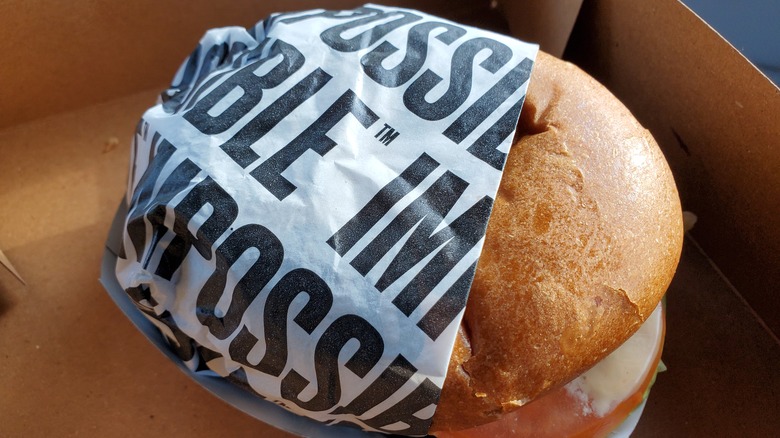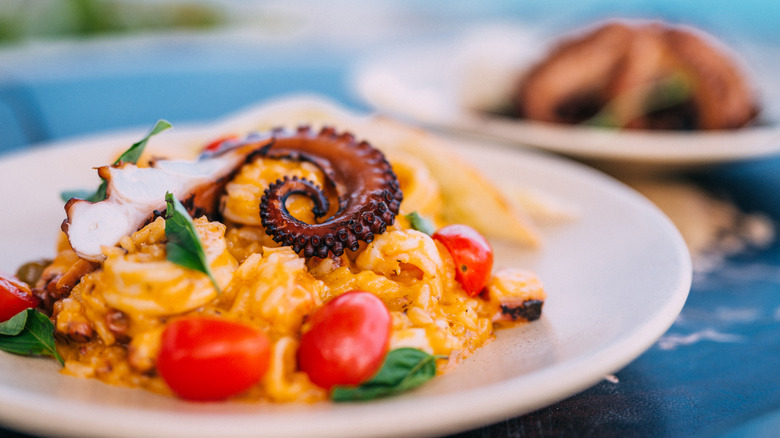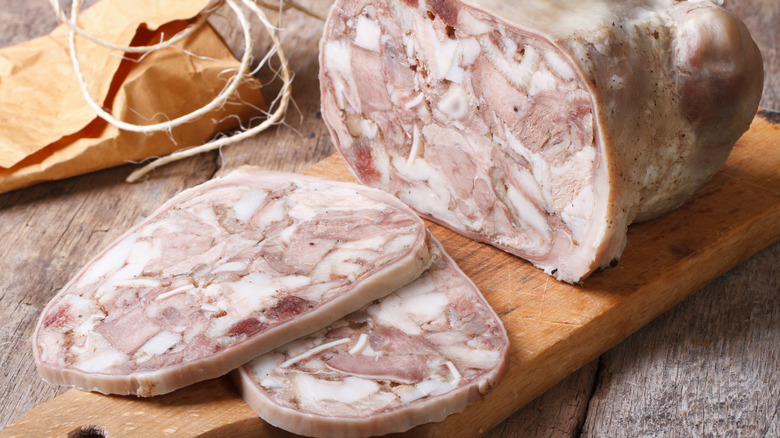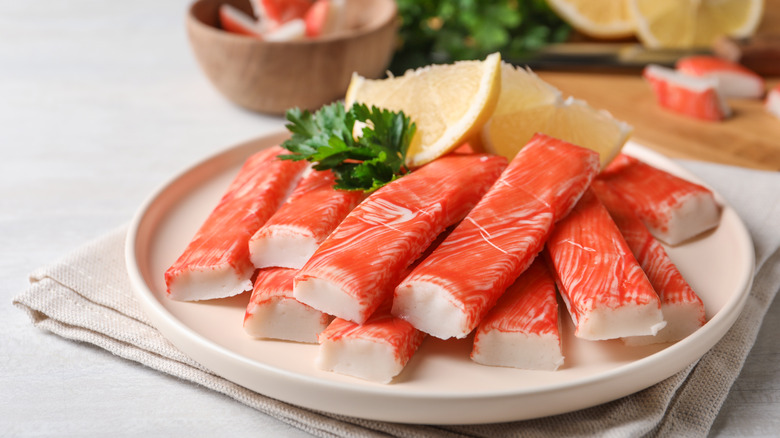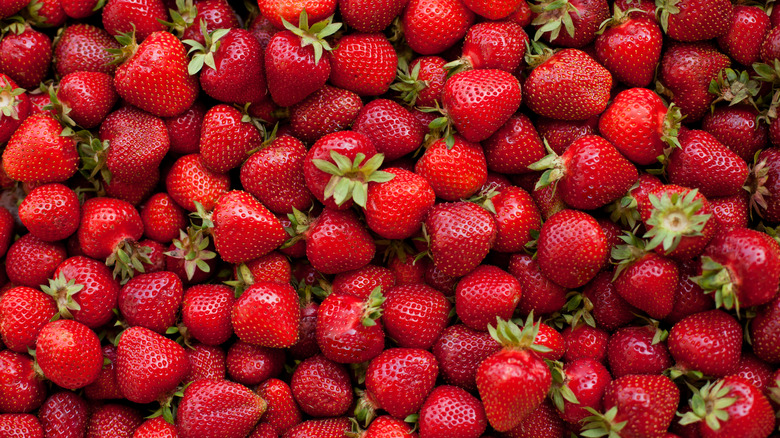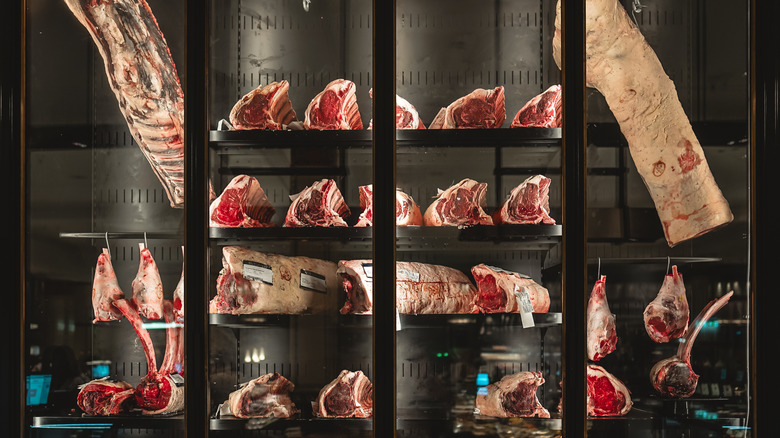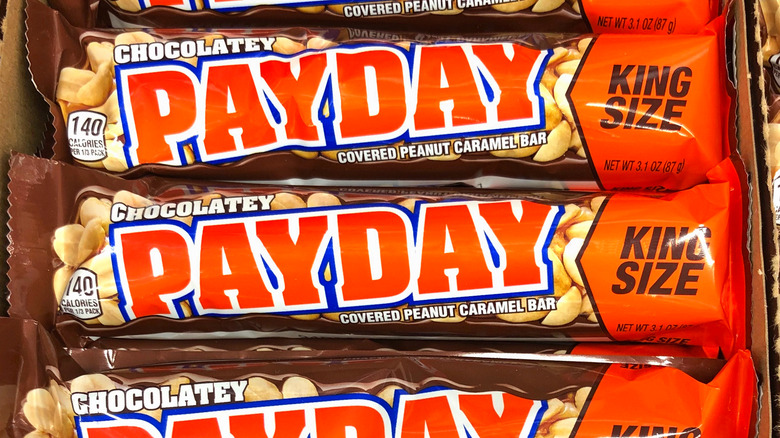Foods You Might Not Eat If You Knew How They Were Cooked
Everyone has their own tastes and preferences, especially in terms of food. Some diners can't stand the idea of raisins in their food; some are sensitive to the cheese odors; others feel queasy at the mere sight of rare meat's rosy juice. Food aversions can be linked to anything from texture to flavor to appearance. However, the oddities of some dishes are better concealed, at least at the outset.
This is true for foods that are so processed that they contain all sorts of bizarre ingredients. You may be surprised to learn the ways in which some commonly consumed items, such as hot dogs, frozen lasagna, and even some varieties of whiskey. Be warned: Once you know the ingredients in some of these processed foods, you may not want to eat them again. However, it's important to know the contents of the food that you're consuming. That way, you can make fully informed dietary decisions.
Hot dogs
Many consumers are unaware of the production methods of hot dogs. The Manual actually refers to a hot dog as a phallic meat medley. Some assert that hot dogs contain lips and buttholes, though that theory may be a bit hyperbolic. Hot dogs are made using scraps and trimmings from a variety of different animals, which may include cows, pigs, or chickens. The cheaper the hot dog, the more likely it is to contain mechanically separated meat.
Mechanically separated meat is essentially a meat purée made by pressing the meat from any bones that remain after butchering and may include skin, fat, and gristle. According to USDA requirements, a hot dog should only contain less than 20 percent mechanically separated meat; however, that's still a lot of unidentifiable meat sludge. In order to make the franks, these trimmings are combined with starches and seasonings and emulsified into a batter, which is then cased in cellulose to form those identical hot dogs.
Chicken nuggets
If the idea of hot dogs makes you a bit queasy, you'll probably feel the same about chicken nuggets. As Jamie Oliver attempted to impress upon young people, chicken nuggets aren't made with chicken meat, but rather, a chicken milkshake of sorts, although the kiddos didn't seem to mind. But let us rewind for a bit. After all, chicken nuggets are off-putting for more reasons than one. McDonald's is one of the worst sellers of chicken nuggets in terms of the inhumane treatment of animals. The chickens are hatched in incubators. The birds live in filth and squalor until it's time for their slaughter.
But to add insult to injury, according to some studies, only 50 percent (or less!) of a chicken nugget is actually made up of muscle tissues. The rest seems to be comprised of a mysterious mix of nerves and fat. The mix is also seasoned with maltodextrin, a form of sugar, as well as sodium phosphates before the nugget is battered and deep-fried.
Roast turkey
It's perhaps not surprising that a lot of highly processed foods contain questionable ingredients. But did you know that some nostalgic, home-cooked meals are just as tough on the stomach? Consider Thanksgiving dinner and its most typical centerpiece: The roast turkey. Turkey in and of itself isn't necessarily any better or worse than any other meat. But in the United States, where white meat is prized, turkeys have been bred to be breast-heavy in order to make it impossible for these birds to run, fly, or even mate.
The size of a turkey tom's breast is so enormous that it would actually crush the hen if the pair attempted to copulate as nature intended. As a result, domesticated turkeys must be bred using artificial insemination. Concerns surrounding this cruel treatment may already turn you off turkey. You may be further horrified to learn that much like many animals raised for slaughter, 85 and 90 percent of turkeys are raised on factory farms. Knowing this may have you opting for nut roast or humanely-raised heritage turkey birds.
Frozen lasagna
There's an argument to be made for swearing off beef entirely, given the environmental implications. Beef farming contributes somewhere between 7 to 18 percent of human-related methane emissions worldwide. The carbon footprint of raising beef is one of the highest in the industry: 27 kilos of carbon dioxide are released for each kilo of beef produced. But the environmental impact isn't the only problem with processed foods featuring ground beef (such as frozen lasagna).
The beef in these sorts of foods, referred to as Lean Finely Textured Beef (LFTB) and later dubbed "pink slime" by a former USDA official, is quite problematic. The highly evocative term has unsurprisingly been coopted by the media, and frankly, it's pretty apt. Pink slime is made by gathering waste trimmings from beef processing, simmering them at low heat and spinning them in a centrifuge to remove any fat, and finally treating the resulting sludge with ammonia gas to kill any bacteria. While pink slime is safe to consume, it's hardly appetizing. To add insult to injury, due to new labeling laws, meat processed in this way no longer has to be specifically labeled as such: It can simply be listed as ground beef, which makes it even harder to avoid unless you're heading to a butcher shop where beef is ground to order.
Impossible Burgers
The ethical and health issues plaguing the meat industry seem enough to turn anyone to plant-based options, but there are some stomach-turning problems afoot here too. When Impossible first proudly released its plant-based beef, it seemed like a boon for anyone who wanted to cut down on meat production without compromising on the flavor, texture, color, and mouthfeel of a perfectly cooked rare burger. But the reality of the contents of plant-based products like the Impossible Burger is far from appetizing.
The highly-processed patties are made using technology that isolates a protein that contains heme, an iron-rich molecule that makes the juices of meat red. Heme from soy is inserted into a specific yeast that's genetically engineered to create even more heme as a waste product. The burger is then combined with textured wheat protein and loads of emulsifiers and stabilizers to give the burger the right texture. The resulting burger may be vegan, but it's a bit of a stretch to call it truly plant-based.
Veal
Many meat eaters have made their peace with the inhumane treatment of animals raised for consumption (or, at the very least, turned a blind eye), but it's hard to contend with the specifically unethical world of veal production. Veal is made from six- to eight-month-old male calves. These calves are separated from their mothers very shortly after birth in order to preserve the mother's milk supply, and many spend the entirety of their short lives in a tiny crate that may be smaller than one cubic meter. This process is meant to cause the calf's muscles to waste, making the meat even more tender.
Veal crates have been outlawed by the European Union, and some American veal companies are phasing the practice out. Crates have also been outlawed by some states, including Arizona, California, Colorado, Kentucky, Maine, Massachusetts, Michigan, Ohio, and Rhode Island. But there is no federal law prohibiting this practice, and many other states continue to raise veal in this manner.
Octopus
Octopuses might not be as cute as piglets or veal calves, but consuming such a smart animal may indeed give you pause or indigestion. Octopuses exhibit far greater intelligence and natural curiosity than many other animals. Despite being fairly solitary animals, they can also cooperate with other octopuses, and even with other species, to hunt and track down hidden prey, and they are also able to learn by watching another octopus carry out a task.
They are notable in their ability to use what one scientist terms "conditional discrimination," which means that octopuses can make modifying choices depending on the context, and research has shown that the cephalopods are even capable of planning, reasoning, and problem-solving. Additionally, octopus farming is an inhumane practice that poses many risks to the environment. Octopus farming tends to have negative impacts on marine environments: Since octopuses are carnivores, they have to be fed other fish, which further depletes ecosystems.
Head cheese
Offal (organ meats) are used in numerous different cuisines, but they're not quite as popular in the United States. Head cheese may give many Americans pause. Indeed, the operative word in head cheese isn't cheese but head: This charcuterie is devoid of dairy, and it's actually made from the heads of pigs, calves, or sometimes sheep or cows.
This concoction is derived from the collagen-rich meat of the face. The collagen transforms to gelatin (solid bone broth) during the cooking process, which binds the meatier portions of the terrine in all its gelatinous glory. Regular head cheese includes jowls, skin, snout, and sometimes feet, though other iterations of head cheese may include tongue, blood, or bone. While some may find this process off-putting, others might want to try this unusual dish. Head cheese is typically consumed on crackers or on a sandwich. There are numerous different varieties of head cheese; sulz, souse, and tongue head cheese, among others.
Arby's croissants
Subway bread may not have quite the same olfactory power as Lush products, but it also bore almost all of the marketing pain when a widely-circulated petition started in 2014 by blogger Vani Hari made the rounds, accusing the sandwich chain of using the "yoga mat chemical" azodicarbonamide in its sandwich bases. But while Subway phased out the chemical almost immediately after the media frenzy, it turns out Subway wasn't the only company taking advantage of the chemical's bubble-forming properties as a leavening agent.
Azodicarbonamide is a chemical additive: Its proclivity for forming bubbles in foams and plastics does indeed convey a bouncy texture to yoga mats, but it also pops up in anything from hair straighteners to pesticides. It remains popular as a leavening agent and whitener, notably, at Arby's, where it is used in the chain's croissants. Not only is it hard to reconcile the presence of the chemical that is in our yoga mats as forming the squishy base of a ham-and-cheddar croissant, but research has linked this chemical to cancer in lab animals, particularly when heated, so we'll give these croissants a pass, merci beaucoup.
Imitation crab
If you've ever enjoyed a California roll, you've probably dug into that sweet, sweet flavor of fake crab meat. Imitation crab meat is less expensive than real crab. It's made with a combination of far less expensive fish, which is ground into a paste and seasoned with sugar and salt. It may also be bulked out with starch, egg whites, and vegetable oil. It's usually dyed with a red dye known as carmine to give it that sought-after rosy hue. Carmine is derived from cochineal insects.
Cochineal hail from Latin America, and their diet mostly consists of cacti. The wingless females are used to make carmine, which may also be labeled as natural red four, crimson lake, or E120. The insects are dried and filtered to remove any insect parts before being used in anything from cosmetics to candy. This additive, unlike some others, is harmless, but for those unaccustomed to the time-tested practice of eating insects, it could be a bit tough to swallow.
Eau de Musc whiskey
Some strange additives and processes are obscured by the industries that use them. However, New Hampshire's Tamworth Distilling is wholly forthcoming in its use of beaver butt juice. Castoreum is a substance extracted from a beaver's castor sac, which is located near (but not in) the anal gland. The castor sacs are used to expel a scent used to mark a beaver's territory, and in the case of beavers, that substance has a musky vanilla aroma.
Castoretum has been used since ancient Roman times. It was a fairly widespread stand-in for vanilla until beaver trapping fell from grace as a thriving industry. These days, using beaver castoretum requires a process involving hand-milking the castor sacs of anesthetized beavers. But this small, artisanal company leans into the oddity of this historic ingredient with its whiskey. According to the producers, sastoretum imparts a leathery flavor reminiscent of raspberry and vanilla to the finished whiskey. Cheers? We guess?
Chewing gum
If you take the time to think about chewing gum, the strangeness of chewing something that isn't even food quickly becomes apparent. However, chewing gum contains numerous different substances, from glycerol, a compound derived from wood, to sorbitol, an artificial sweetener that can pave the way for some unfortunate digestive side effects.
That said, the most surprising chewing gum additive (and the one that has us considering spitting it out for good) is lanolin. Lanolin is a waxy secretion produced by glands in sheep skin that keep its wool waterproof, and it's understandably used as an ingredient in some skin products. But it can also be found in some chewing gums: It's used to lend the treat its sought-after rubbery texture. And since the use of it is so standardized that it doesn't even need to be listed on the package, unfortunately, you may not even know it's present in the chewing gum.
Conventionally grown strawberries
Strawberries — and berries in general — are one of the poster children of healthy eating: rich in antioxidants, vitamin C ... and pesticides? Indeed, according to the Environmental Working Group's (EWG) latest Dirty Dozen list, which ranks produce with the most pesticide contamination based on USDA testing data, conventionally grown strawberries are the most contaminated produce item consumed in the United States. They rank just above other "healthy" produce items like spinach, kale, collard greens, and cherries.
Many of the foods on the Dirty Dozen list showed contamination levels in over 90% of tested samples. Per the report, chemicals that have long been banned by the U.S. Environmental Protection Agency were commonly detected. A former senior vice president of research at EWG explains that these may be endocrine disruptors and even lead to life-threatening ailments like cancer (via ABC 7). The takeaway from this annual list should not be to avoid strawberries entirely. Rather, seeing as a majority of conventionally grown produce sold nationwide contains pesticide residue, the EWG urges consumers to seek out organic produce whenever possible, especially when it comes to items at the top of its list.
Dry-aged beef
Dry-aged beef may be the most sought-after by steak lovers, but would they be clamoring for these pricey cuts if they knew that dry-aging pretty much just entails letting beef rot? "An unsexy way to explain it is that dry-aging, in a nutshell, is a controlled decay process," Katie Flannery, butcher and COO at Flannery Beef, tells the Robb Report. Exposing the beef to oxygen, she continues, allows enzymes and bacteria to break it down and tenderize it. Compounded with the moisture loss that occurs during the process, dry aging results in a far richer flavor that Josh Ozersky, organizer of the annual Meatopia festival, terms "funky" in an interview with Serious Eats.
Of course, the controlled nature of the rotting is essential: The bacteria on the surface of the beef are healthy, much like those used to age cheese. Any visible mold is cut away before the beef is cooked and served. Still, glimpsing an aging room filled with rotting meat carcasses could make even the biggest Peter Luger fan take pause.
Chocolatey Payday
Chocolate may be considered a superfood and peanuts may be rich in protein, but if you're looking for those antioxidant benefits, don't go reaching for a chocolate-covered Payday. If you take a closer look at the label, you'll notice that Payday isn't described as being covered with chocolate but rather as "chocolatey." This indicates a loophole that allows producers of cheap chocolate-flavored candy to avoid adding enough chocolate liquor to the product to actually make it true chocolate. The resulting candy lacks the same mouthfeel as the real stuff since it is made with vegetable oil rather than cocoa butter.
Of course, Payday is not the only culprit of such trickery. Good Humor uses a "chocolate-flavored coating" on its original ice cream bars; even Butterfinger ironically uses no cocoa butter to make its peanut buttery treat. If only the real thing will do, examine the ingredient list to ensure that either "chocolate liquor" or "cocoa" and "cocoa butter" appear.


